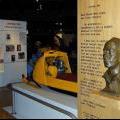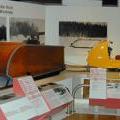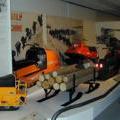 The year was 1942. A village mechanic awoke from a vivid dream, a dream that would eventually have international repercussions. It has now been more than half a century since Joseph-Armand Bombardier realized his dream and patented the first tracked vehicle, the B7, and formed L'Auto-Neige Bombardier Limitée.
The year was 1942. A village mechanic awoke from a vivid dream, a dream that would eventually have international repercussions. It has now been more than half a century since Joseph-Armand Bombardier realized his dream and patented the first tracked vehicle, the B7, and formed L'Auto-Neige Bombardier Limitée.
Bombardier's first snowmobiles were designed for professional people, the postal service, and as taxis and school buses. Then World War II intervened, and the civilian snowmobile was pressed into military service. The Allies were looking for a vehicle to transport soldiers over snowbound battlefields, and Bombardier's invention was soon transformed into an armoured all-track snowmobile called the "Kaki." More than 1900 Kakis, or "Penguins," as they were later known, were built under military contract. By 1948, sales at Bombardier's company reached $2.3 million, and by 1958, they soared to over $3.5 million.
 SKI-DOO CRAZE
SKI-DOO CRAZE
When the Ski-Doo appeared, a whole new industry came into being. An advertisement caught the attention of the public by emphasizing the sporting aspect of the tracked vehicle with skis: "Outdoor enthusiasts looking for new thrills in winter sports will find them with the Bombardier Ski-Doo…" The craze soon spread throughout Canada and the United States, bringing annual sales to $10 million by 1964. The success of the Ski-Doo was assured by the 1968 North Pole expedition that "demonstrated the product's reliability, endurance, and strength." The rest, as they say, is history.
HIGH-TECH FACTORY
I recently took a trip to the modern Bombardier factory in Valcourt, where I had to walk several blocks around the outside of this huge plant (I had parked in the wrong parking lot). I finally reached the visitors' door, where my friend Sherrie Maliche was waiting to take me through the Ski-Doo section of the factory.
This place is colossal! Employees have to use bicycles to travel from one department to another! Security is almost overwhelming. Cameras are everywhere and doors must be buzzed to be opened. Robots whirl here and there on their pre-programmed duties, and there are miles upon miles of conveyers delivering snowmobile parts. Dodging forklifts and other vehicles, we eventually reached a cafeteria where we stopped for a coffee and reflected on our adventure before proceeding to the Bombardier Museum.
 J-ARMAND BOMBARDIER MUSEUM
J-ARMAND BOMBARDIER MUSEUM
More than 43,000 people visit the Bombardier Museum every year. Museum guides and all documentation are bilingual. You can step into Bombardier's garage, built in 1926, and see his original tools in the very place that the snowmobile was invented. The garage is also a screening theatre where you can view a documentary on the life and work of the great inventor.
In the Joseph-Armand Bombardier Exhibition, you will see Bombardier's first experimental vehicles, industrial tracked snow machines, and the tools that made the Ski-Doo possible, as well as displays on the inventor's life and times. Be sure to examine Bombardier's first invention and the sprocket he patented in 1937, revolutionizing the sprocket wheel track system with teeth that engaged metal grooves.
 BATMAN
BATMAN
The theme of the International Snowmobile Exhibition could very well be "the great little machine," as the snowmobile has affectionately been dubbed by the people of the "lands of ice and snow." Here you can see more than 30 snowmobiles from all around the world, including a futuristic model designed by the creator of the Batmobile from the movie Batman.
What impressed me most while touring the Museum was the discovery that another Bombardier, Joseph-Armand's nephew Jean-Luc also had a dream, a dream to conquer the North Pole by Ski-Doo. In February 1968, he joined an exhibition led by American Explorer Ralph Plaisted, and on March 7, after braving temperatures of -52 F (- 46.6 C) and ice ridges over 12 miles (19.3 km) high, he landed on Ward Hunt Island, the last piece of land before the Arctic Ocean, and conquered the Pole in his "great little machine."